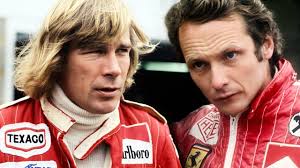
.
As great sporting rivalries go, they don’t come any more tense or bitter than that which existed between British playboy racing car driver James Hunt and his steely Austrian competitor Niki Lauda. And nowhere did this stark contrast of style and character manifest itself more explosively than in the unforgettable Formula One World Championship of 1976.
The consummate professional, Lauda had already established himself as the man to beat after having won the championship the previous year. Hunt, having joined the sport from Formula Three driving – and winning – for the Hesketh team, signed up for McLaren in 1975. His daring and skill rapidly identified him as one to watch and, combined with his flamboyant personality and pop star lifestyle, he fast became a celebrity whose fan base extended well beyond the somewhat niche world of motor racing.
Thus the stage was set for a showdown in the extraordinary year that was 1976 between the bad boy from Belmont and the dedicated, methodical Lauda, born into a wealthy Viennese paper manufacturing family. The season featured the World Championship of Drivers and the International Cup for Formula One Manufacturers, which were contested concurrently over a sixteen-race series starting on January 25th and concluding on October 24th. The season also included two non-championship races. As he had done in the previous, winning year, Lauda drove for Ferrari.
Series of Controversies
The season began in São Paulo, Brazil. After having initially claimed pole position Hunt crashed from the race with a sticking throttle, handing Lauda victory in his first defence of his title of the previous year. A similar scenario played out in the next race in South Africa, although on this occasion the Briton did at least manage to place second. In the third race, in the US, the Austrian had to settle for the second spot, though still finished ahead of his rival.
The fourth race, at Jarama near Madrid, saw the first of a series of controversies that were define this memorable year in Formula One racing history. After having beaten Lauda into second place with his first F1 victory of the campaign Hunt was then disqualified due to his car allegedly having been 1.8 centimetres too wide, only to be reinstated as the winner on appeal some two months later.
It wasn’t until the ninth contest that Formula One came to the UK, in July, with James Hunt determined to triumph before his home crowd at Brands Hatch. In the event though Lauda took pole position, forcing his rival into an early second spot. At one point the race had to be restarted after debris was cleared from the track following a minor collision in which Hunt was involved, and he and two other drivers recommenced driving new vehicles. Lauda remained in the lead until his gearbox malfunctioned, allowing the Englishman to overtake him and to relegate him to second place.
However, more controversy was to follow. After the crash James Hunt had taken a shortcut to the pit by means of an access road, which meant that technically he had not completed the course. Ferrari contested that the rules stated that even if a race was suspended, drivers still had to follow the course before accessing the pit. A hearing was held in September at which Hunt was disqualified and Niki Lauda was awarded the win.
Show of Hands
But the race that will be remembered forever will be the West German GP, which took place on the on the deadly Nürburgring track in Nürburg. The mountainous Nordschleife section of the road was fourteen miles long, nearly three times longer than Interlagos which was the next longest circuit on the calendar and seven times longer than the Monaco street circuit. It had already claimed a number of victims and as the competition’s safety spokesperson Lauda proposed a boycott of the event. When drivers took a show of hands he was defeated by one vote, and the race went ahead.
On the second lap of the race Lauda lost control of his car due to a probable rear suspension failure whilst driving at high speed on the wet track, and crashed into barriers before bouncing back. The car became engulfed in flames. Lauda was pulled out of the burning car by some fellow drivers, and was rushed to hospital where we was read the last rites by a priest. He died and was resuscitated on two occasions. Some obituaries were already written and ready to be published. But incredibly Niki Lauda not only survived the lung damage and the severe burns, which left his face permanently disfigured, but he was back on the grid for the Italian GP just six weeks later. “I said then and later that I had conquered my fear quickly and cleanly,” he was later to comment. “That was a lie. But it would have been foolish to play into the hands of my rivals by confirming my weakness. At Monza, I was rigid with fear.”
Treacherous Conditions
The sixteenth and final race in the Championship took place in Japan. Before the start of the race, Lauda was still leading Hunt by three points in the tournament. But once again conditions were treacherous, and many of the drivers (including both Lauda and Hunt) argued that it was too dangerous to proceed. Bullied by the demands of the TV companies, their protestations were overlooked and the race went ahead in sheeting rain.
In Lauda’s case his difficulties were compounded by the fact that his accident in Germany had left his tear ducts damaged which rendered him unable to blink in the spray. Under protest, he performed two laps and retired from the race. At the finish Hunt came home in third place, overtaking Lauda’s points tally and thereby handing him the 1976 Formula One World Championship.
The excellent 2013 film Rush depicts the fierce rivalry between these two gladiators of the race track wonderfully, but what perhaps does’’t quite come across is the sheer love and respect that existed between them. They were friends before, during and after the epic battles of 1976 and Lauda was especially touched when Hunt announced, after winning the Championship in Japan that year: “I wanted to win the championship, and I felt that I deserved to win the championship. I also felt that Niki deserved to win the championship, and I just wish we could have shared it.”
Tragically, James Hunt died from a heart attack in 1993 at the age of just 45. Lauda went on to enjoy a long career in Formula One as a driver and manager, also writing five books and even setting up his own airline Lauda Air. He died in May 2019, aged 70, following kidney problems.

If you enjoyed reading this article, make sure you stay updated with all Phil’s latest blog posts by signing up to receive his free Newsletter. You can unsubscribe at any time and your details will never be shared with any third party. Click here to sign up today.

